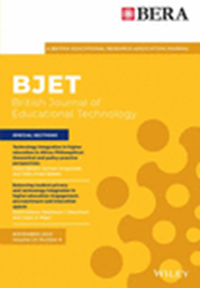Analysing nontraditional students' ChatGPT interaction, engagement, self-efficacy and performance: A mixed-methods approach
Abstract
Generative artificial intelligence brings opportunities and unique challenges to nontraditional higher education students, stemming, in part, from the experience of the digital divide. Providing access and practice is critical to bridge this divide and equip students with needed digital competencies. This mixed-methods study investigated how nontraditional higher education students interact with ChatGPT in multiple courses and examined relationships between ChatGPT interactions, engagement, self-efficacy and performance. Data were collected from 73 undergraduate and graduate students through chat logs, course reflections and artefacts, surveys and interviews. ChatGPT interactions were analysed using four metrics: prompt number, depth of knowledge (DoK), prompt relevance and originality. Results showed that ChatGPT prompt numbers (β = 0.256, p < 0.03) and engagement (β = 0.267, p < 0.05) significantly predicted performance, while self-efficacy did not. Students' DoK (r = 0.40, p < 0.01) and prompt relevance (r = 0.42, p < 0.01) were positively correlated with performance. Text mining analysis identified distinct interaction patterns, with ‘strategic inquirers’ demonstrating significantly higher performance than ‘exploratory inquirers’ through more sophisticated follow-up questioning. Qualitative findings revealed that while most students were first-time ChatGPT users who initially showed resistance, they developed growing acceptance. Still, students tended to use ChatGPT sparingly and, even then, as only a starting point for assignments. The study highlights the need for targeted guidance in prompt engineering and AI literacy training to help nontraditional higher education students leverage ChatGPT more effectively for higher-order thinking tasks.
Practitioner notes
What is already known about this topic
- Nontraditional students face unique challenges in higher education, such as limited technological literacy and digital access.
- The emergence of generative AI tools presents both opportunities and challenges for addressing educational disparities.
- Existing studies on AI implementation predominantly focus on traditional students.
What this paper adds
- Empirical evidence of how nontraditional students interact with ChatGPT through multiple metrics (prompt number, DoK, relevance and originality).
- Distinct interaction patterns and their relationship to performance outcomes.
- The relationship among ChatGPT interactions, engagement, self-efficacy and performance.
Implications for practice and/or policy
- Need for explicit instruction in prompt engineering as a critical skill for higher-order thinking.
- Importance of providing targeted technology training and self-paced learning resources for nontraditional students.
- Value of developing comprehensive AI literacy training that addresses both tool capabilities and limitations.





 求助内容:
求助内容: 应助结果提醒方式:
应助结果提醒方式:


